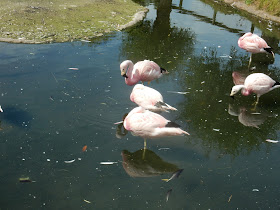This trip happened back in early August, but I haven't had time to do the write-up until now. I've been quite impressed by the London Wetland Centre, which I've now been to several times. Upon hearing that the Wildfowl and Wetlands Trust (WWT) had another wetland centre set up in closer proximity to the Bristol/Bath region (where I am currently based), I naturally had to make the time to visit.
This other wetland centre is the Slimbridge Wetland Centre, the oldest of these WWT nature reserves. The London Wetland Centre had set a high bar for quality, but wow. Slimbridge exceeded my expectations and blew me away.
My Slimbridge trip started off with a series of amphibian exhibits near the main entrance. Here are some red-eyed tree frogs in their signature daytime posture.
A yellow-banded poison-dart frog.
A blue poison-dart frog.
I previously commented that the London Wetland Centre likely houses more species of captive waterfowl than anywhere else I've been to. Slimbridge easily broke that record. Here are a pair of Bewick's swans.
Some greater white-fronted geese.
I'll come back to the waterfowl in a moment, but it's also worth mentioning that Slimbridge additionally houses every species of extant flamingo. Here are some Andean flamingos. They share their exhibit with James's flamingos, though I failed to spot any.
Back to the waterfowl, here's a ruddy shelduck.
There are even some nice mammal exhibits here. One pond is set aside for Eurasian beavers, though they rarely emerge from their lodge during the day.
I found the displays for small rodents particularly impressive. All too often, zoo enclosures for small rodents resemble glorified hamster cages, but Slimbridge's water vole and harvest mouse exhibits did a great job of simulating their natural environments. Though I didn't spot the voles on this trip, the harvest mice put on a good show, and I was eventually able to get a decent picture of one.
Like its London counterpart, the Slimbridge Wetland Centre is more than a zoo. It also serves as valuable habitat for wildlife. Wild common shelducks were, well, a common sight. (To avoid confusion, I will specify whenever wild individuals are pictured in this post.)
A common crane, a species that is not common in the wild in the UK. This is one of the wetland centre's captive individuals, but wild ones are sighted somewhat regularly at Slimbridge. (I was not so fortunate on this trip, however.)
A pair of ashy-headed geese, a species of strange-looking South American waterfowl.
A Cape Barren goose, a species from southern Australia and one of the rarest waterfowl in the world.
A freckled duck, another Australian species.
Most of the wild birds I saw were too far away to take good photos of using my digital camera, but here's a small taste of what the wetland centre has to offer. The majority of species pictured here are black-tailed godwits. There are also a good number of northern lapwings and black-headed gulls.
Some snow geese, with both the white and blue color morphs represented.
A bar-headed goose. This species is well known for migrating over the Himalayas at high altitudes. They have been recorded flying at heights of over 7.2 km.
A pair of Australian wood ducks. They are not closely related to the North American wood duck, but they do also nest in tree hollows.
A southern pochard, looking rather devilish with its red eyes.
A comb duck. The males of this South American species have an unusual display feature.
A flock of greater flamingos, the third of the wetland centre's flamingo species. Note also the Cape teal in the foreground.
Across from them are the lesser flamingos.
An Argentine ruddy duck. The males of this species are infamous for having a phallus that can equal their own body length when erect.
Some black-necked swans and a photobombing (wild) common wood pigeon.
A coscoroba swan, actually more closely related to the Cape Barren goose than to true swans.
A wild rook and Eurasian jackdaws. Common species here, but unfamiliar to a North American like me.
An Orinoco goose, a very terrestrial waterfowl species that rarely swims or flies.
A pair of red shovelers.
A flock of the fifth flamingo species here, the Chilean flamingo.
A crested screamer. Despite appearances, this is yet another waterfowl.
This immature common shelduck vexed me to no end until I finally figured out what it was.
American flamingos. That's all six flamingo species covered!


































There is only a single James' Flamingo at Slimbridge - I believe it is the only one in Europe. Not sure of its age but he has been there for many years.
ReplyDeleteThanks for the info! That likely explains why I overlooked him.
DeleteDo numbats vocalise?
ReplyDeleteAlso, if numbats vocalise, is there any sound files on the internet?
ReplyDeleteThey do, especially during the breeding season. I haven't been able to find any recordings of their calls though.
Delete